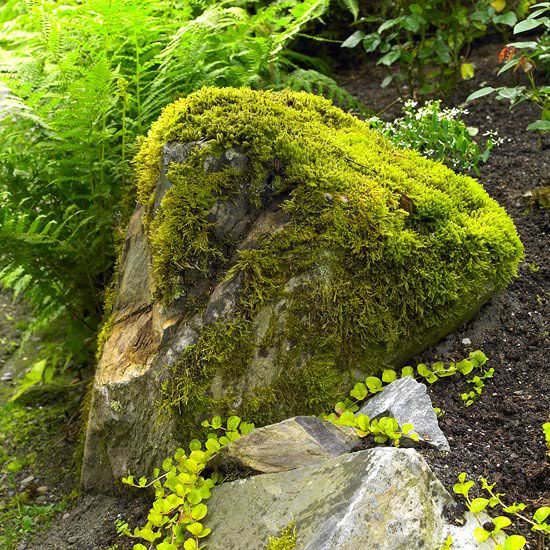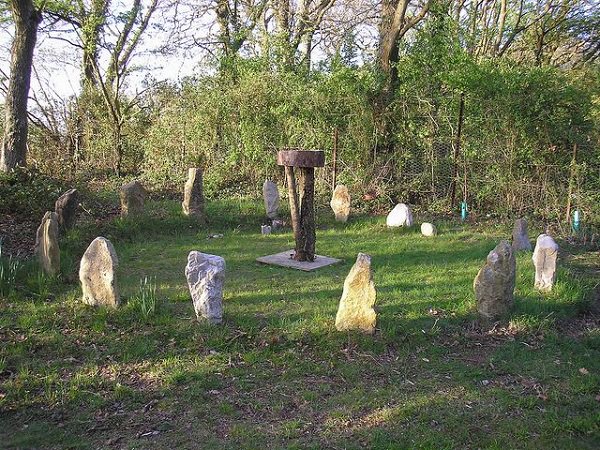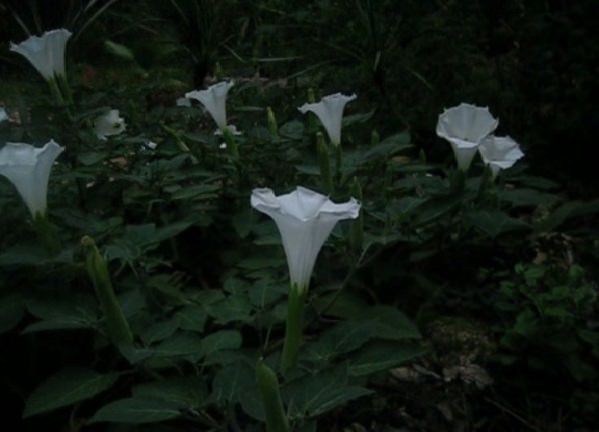If you believe in magic and consider yourself a spiritual person – Here’s How To Create A Witch’s Garden To Import Magic Into Your Life!
Our How To Create A Witch’s Garden To Import Magic Into Your Life guide will help you turn your backyard into a mystical haven filled with herbs, flowers, and other bewitching wonders. Scroll down to uncover the steps, and let the magic begin!
How To Create A Witch’s Garden
1. Preparing the Magical Space
Your first step in creating a witch’s garden is to build a place of solitude amid greenery and cleanse it using the elements. Pick any suitable space in the yard or give it an extreme makeover if you want a big magical garden. Wash off any hint of chemicals.
Withdrawal from chemical dependency is your primary objective for the first year of your witch’s garden. If you can be patient, consider growing legumes and beans first, as they replenish the soil with nitrogen and improve its quality.
Tip: Don’t work around in muddy shoes, as that can transmit diseases and impurities.
2. Create an Altar for Your Garden
An altar or a meditative spot is a nice way to add a witchy touch to your garden. Creating your private spot in the lap of nature will make you feel sacred, accomplished, and blessed. Here are some ways to create an altar:
- Find a lovely big stone covered with a blanket of moss to sit on while meditating.
- Use privacy screens with tall plants grown in raised beds or repurposed stock tanks to shield the area and to get some solitude.
- Create a nice summer display using a basket brimming with lavenders and nasturtiums.
- Bring a small table outdoors and place a tree stump and a stack of stones on it. Alternatively, you can keep a bowl of logs salvaged from your own yard. Light a few votive candles, and you’re good to go!
Check out the Best Herbs for Protection here
3. Create a Protective Circle
Once you have added the plants, it’s time for some more witchy additions. To guard your magical garden, create a protective circle — a magical barrier that keeps your plants safe. Follow these simple steps to make it.
- Gather small stones or use materials like sticks to form a circle around your garden.
- Place each stone or stick close to the next, creating a continuous circle.
- This magical barrier will act like a shield, protecting your plants from curious critters and ensuring their safety.
- Check your protective circle regularly to make sure it remains intact, keeping your witch’s garden a haven for magic.
4. Choosing Plants for a Witch’s Garden
In the olden days, practitioners of metaphysics and magic used to create extensive gardens replete with herbs, trees, vegetables, and edible flowers. While there is no hard-and-fast rule about choosing plants for your witchy garden, you can always take inspiration from the following list below.
- Rosemary: It heightens cognitive awareness and is often used in white magic to induce feelings of love and healing.
- Calendula: It signifies hope and optimism. Also, you can place it on the altar along with lavender to protect your rituals from malevolent forces.
- Basil: Enriched with essential oils, the aromatic leaves of basil are known to attract money luck or uplift your senses, at least!
- Mint: This sweet, vibrant herb is known to attract money and love. Mint is often kept on the meditative altar to ward off evil, call good spirits, and aid in magic.
- Lavender: Considered the Holy Grail of aromatherapy, lavender is one of the most important culinary and medicinal herbs out there.
- Sage: Besides being a popular ingredient in holiday meals, sage is vital for various magical purposes. It increases fertility, repels evil forces, brings immortality, and grants wishes.
- Lilac: It symbolizes new beginnings as it usually blossoms during the transition time from autumn to spring.
Check out the Best Black Magic Plants for Garden here
You can go with yarrow, nettle, foxglove, hellebores, poppy, comfrey, nasturtiums, henbane, nightshades, wolf’s bane, belladonna, patchouli, and peppermint in your witch’s garden for added enchantment.
5. Practice Seed Blessing
Once you have the plants in mind, it is time to grow and nurture them. You should practice seed blessing.
Seed blessing is an arcane technique to recharge the dormant seeds and aid their transition to new life. This ritual should be carried out in the dark, preferably at night. Here, you ask for help and guidance from the universal energies for the growth of the seeds.
6. Establish a Communication Ritual
Preparing the garden bed and sowing the seeds are just the initial steps of creating a witch’s garden. The real work starts from there on. You must spend time in your garden daily to observe and communicate with your plants.
Communicating with plants comes in the category of all things witchy. It’s a common practice among gardeners who swear by traditional techniques of promoting plants’ growth. Before you shun this practice as a stone-age belief, remember that research has revealed that talking to plants can boost their health.
Here are the Most Sacred Plants in the World
7. Carry the Theme with Magical Decor
Make your magic garden enchanting by adding winding paths with pebbles, crafting markers with symbols, and painting glow-in-the-dark stones. You can find most of this stuff or create your own.
You can also build fairy houses, set up an herb-drying spot, and place mirrors and ribbons for energy. Add a birdbath or pond for water magic and hang wind chimes for enchanting sounds. These easy touches will make your garden truly magical! Here are some DIYs to get started.
- Emboss your planters and gardening tools with ancient symbols of Runes, Tarot or Kabala. Here’s the DIY.
- Place quartz crystals and moss agate within the soil, to prepare the area for an upcoming ritual, as well as charge the garden bed for improved growth of the plants.
- Water the plants with water, preferably solar water to allow for maximum nourishment and growth. Learn more here!
- Consider doing a small full-moon ritual during the growing season as a token of gratitude to Mother Earth for blessing you with abundance and prosperity.
Follow this link for more details!
Rituals for the Witch’s Garden
We all know how to take care of plants using compost, mulch, pruning, and most of all, observation. But a Witch’s garden needs extra care which you can provide with these.
1. Magical Offerings
Creating a connection with your witch’s garden involves more than just routine care; it’s about reciprocating the magic it provides. Consider offering small tokens of appreciation as a symbolic gesture of gratitude.
Crystals
Crystals, with their unique energies, can be strategically placed to enhance the enchantment within the garden. Amethyst, known for spiritual growth, and rose quartz, symbolizing love, bring unique energies to your space.
Dried Flowers
Dried flowers, such as lavender for tranquility or chamomile for relaxation, not only enhance the garden’s mystical ambiance but also serve as symbols of appreciation.
These offerings become more than decorations—they serve as expressions of thanks for the wonders your garden bestows upon you.
10 Amazing Dried Hibiscus Flower Uses
2. Bonding in the Moonlight
The moon, a celestial companion to the night, adds an extra layer of magic to your garden. You should make the most of moonlit moments by spending quiet evenings surrounded by the subtle glow.
Allow the cool night air to heighten your senses, creating a serene atmosphere for reflection and connection in the garden. Take this opportunity to perform moonlit rituals, harnessing the lunar energy for your gardening endeavors.
Whether it’s a simple meditation or a more elaborate ceremony, the moonlit bond strengthens the mystical energy of your garden.
Tips for Choosing Plants for a Witch’s Garden
Sometimes, plants that are believed to be apt for the witch’s garden are toxic to animals and children. These include datura, poppy, belladonna, and Mandrake.
- When planning a witch’s garden, find out the harvesting times for plants. The sensible idea is to pick a wide selection of plants that mature at different seasons of the year and add texture, interest and visual variety to your garden.
- Choosing plants in such a way that something or the other is always blooming is a unique way to maintain visual appeal while supporting pollinator species in the process.
- If you are keen on planting poisonous and edible plants both, ensure that the nontoxic ones are separated clearly from the toxic ones, and labeled as well to avoid any confusion.
- Select plants that you are interested in, or connect with. Do you love adding chamomile in your teas? Do you carry packets of lavender in your purse? Think of all the plants you like and use often, and shortlist those that adapt well to your planting zone.
18 Best Things to Keep Under Your Pillow
Conclusion
Planning a witch’s garden is all about sending your imagination into overdrive. This is a mystical concept that’s still popular and if it attracts you, you can try. Plants grown by the aforementioned guidelines tend to grow with a powerful aura and release intoxicating scents that uplift your senses.
A witchy garden is not just for pagans and practitioners of witchcraft but for anyone who aspires to build a private sanctuary of calm and wellness in his/her property.








This is literally teaching people; “How to garden With Satan 101!”
Are you dense? Farmers have been using these methods for centuries so by your logic every fruit, vegetable, nut you’ve ever consumed is Satan inspired? Gah! Witch doesn’t equal Satan.
Do you honestly believe when God created the universe he sat there and thought, “I should give humans a moon to look at, it will be pretty.” That moon is there for a reason, it just so happens that it affects all of nature. To not use a tool that God has given us is just crazy. This is one reason why I can’t fathom the Christian mindset of following blindly.
Isn’t there a saying that God helps those who help themselves. He has given us multitudes of tools to assist in our lives, right here in the nature & world we live in. Use them! Use the moon to aid in growing your plants, crystals/gems, use the plants to aid in the health of your own life. Stop being so daft and doing only as your human pastor tells you from the rewritten Holy Book translated by greedy and self promoting men of ancient past.
Go ahead and sit inside your home reading your Bible, praying to God. Just don’t forget you could walk out of your house, sit in nature, and learn from Him there as well.
Clover nailed it! This is beautiful.
Right on Clover! 👍
Exactly Clover!
Clover this is lovely. Thank you.
Do you always jump on people like they are Bible thumpers? Do you have issues with people praying to a God or angels…. seems to me they are in your teachings as well. And you need to stop being so angry and bitch people out. Grab some crystals, drink some tea and meditate. Your crystals should release some of you unnecessary anger. I am a little pissed at your attitude. Everyone has THEIR OWN beliefs. Some people try to combine. But how you put it… all farmers are witches due to their planting techniques.
I think you need to Nate’s comment again. It is ill informed and narrow minded and nasty.
*read*
Nate, why did you even read this article? Why are you even here?
Oh Nate, how funny you are. To think everything is so cut & dry. Black & white, good & evil. Well shall all hope (what you feel is your god), opens your mind to other cultures. Blessed be x
You have yet to look inside, so you lash out.
You have quite a journey ahead of you, and we send our blessings and benevolent light to guide your path.
I mean just plz don’t erase the satanic witches tho. Some witches will garden with Satan. Take me as an example.
haha, Nate, lots of people are miss inform so I will not blame you, but most witches do not work with the devil or believe in it. I am a witch and I don’t use the devil in my craft, I read this article because I use herbs in my spells, and is great to know how to take care of them.
Witches are not evil, they live by the laws of nature & the main rule of a witch is to use magic in a way that harms no one, This article promotes gardening with nature in mind therefore I suggest you do some research before talking of gardening with satan.
I like gardening with Satan and all of the other gods goddesses and guides your narrow minded superstitious hypocritical religion loves to hate.
nate famski are you dumb u waste yute of a mugglet
This article is beautiful, very helpful and inspiring. Thank you kindly for writting and sharing this :)
This was so helpful thank you.
Loved it greatly. Thank you for sharing your knowledge with the world.
The medicinal use of plants actually predates the “christian” concept of Satan. Most of the the plants listed in this article are used to make the drugs we pay “big pharma” for everyday but you won’t see anyone calling the Doctor that writes the prescription for the heart, pain, or sleep medication they take a witch or satanist for prescribing them. You can also find these planting and harvesting tips in any farmers almanac that is read by most of the farmers that grow the food you buy everyday in the grocery stores. So before you judge and voice uneducated statements about a well written and informative article do some research.
this was a very inspiring article, thank you very much!!!!
Very sweet article, it is a pleasure to read.
My kids and I have had quite a magickal adventure finding plants for our garden. Thank you, for all the useful information.
I’m reading this because I want to connect with my Inner witch self cause all my friends have and they need air and that what I am so I’m planning on connecting with myself through herbs while connecting with the plants themselves as well cause I always thought I was earth for a while till I saw that I was wind but I always cherish the earth even if that’s not my element
This is an amazing article. My favorites are sage, basil, and mint! I’m also really happy that you mentioned moon harvesting because it’s an amazing experience doing it.
Tina
Thank you for sharing this wealth of information.
One comment/critique: Nightshade is a family of plants, which includes potatoes, eggplants, and belladonna. You might also look into mentioning which plants are toxic/poisonous. This is a really great article and I will be using some of this information. Thank you for taking the time to create this for us.
Beautiful! But I think you meant ‘Impart’, not ‘Import’ in the title. 😊
While I like the format of this article, I think it’d do good to reference actual sources of historical Pagan/Drudic practices and how they relate to gardening. Not only would it serve to inspire but it would also educate people like the very first commenter above. That and I think going into a bit more detail about how important it is to be extremely careful with toxic plants— those beautiful datura flowers in the photo are very dangerous if handled incorrectly or planted by other edible plants. Another herb surprisingly not mentioned is catnip, although I don’t think it needs explained why it should be there :D
Clover this is lovely. Thank you.
Ah yes, this is wonderful and full of great witchy tips :)
Excellent article – just the information I was looking for – Thank you for sharing
This is truly helpful! I am wanting to start a garden and also to make a place where I feel calm and at home. I found this to be truly informative. Thank you!